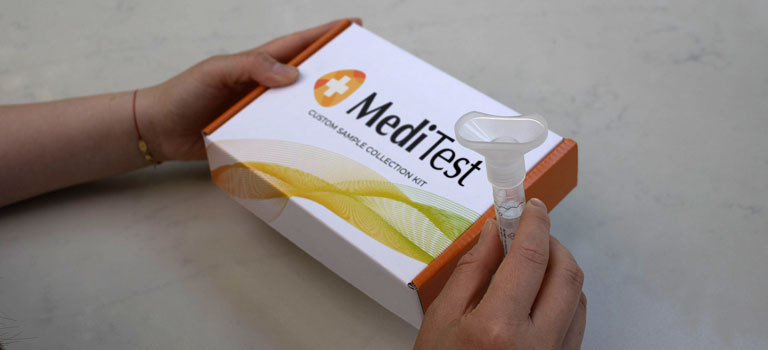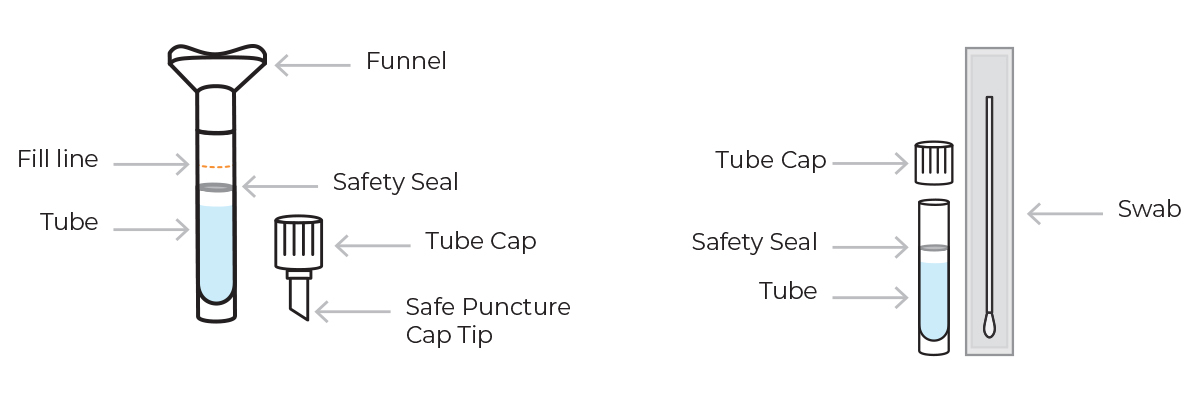There are a lot of considerations when choosing a sample collection device for direct-to-consumer testing. This could mean creating a kit that is shipped to end users, leaving sample collection entirely in the hands of the user. Unsupervised sample collection has become increasingly common with at-home COVID-19 tests as well as ancestry and other DNA tests done without a physician. While this is the new norm for accessible health information, unsupervised sample collection is not without challenges. More than ever before, the sample collection device a direct-to-consumer test uses is one of the most critical components.
The first thing to consider when choosing a sample collection device is the intended application. What biological sample types will be collected? Some common sample types include saliva, nasal, buccal (inner cheek), fecal, and vaginal samples. The sample type required for the test will help narrow down what sample collection devices are able to be used. Saliva applications are becoming more popular due to increased usability and saliva has also shown to yield good results for oral samples. Other applications, like vaginal microbiome testing, will require a swab to be used.
One of the most important components a collection device should have is a liquid stabilizing reagent which quickly preserves the genetic integrity of the sample once collected. This is especially important for tests that require RNA, as it degrades as soon as a sample is taken, creating an impossibly small window for results unless it is stabilized immediately after collection.
If a sample collection device does not include a stabilization solution and only uses saline, it will require costly shipping techniques including shipping on dry ice, expedited shipping, hazard shipping, and additional precautions needed to receive the sample as a biological hazard. In the United States, this adds a minimum cost of $50 to each sample that would need to be priced into the cost of the test or test kit that is sold to users.

Figure 1. As the market for at-home testing grows, it's crucial to choose safe and reliable methods of sample collection.
Pathogen Inactivation
Another critical component the molecular transport media reagent in the sample collection device should have is pathogen inactivation. With the ability to render pathogens non-infectious, the receiving lab that processes the sample is only required to be a Bio Safety Level (BSL) 2, and not a BSL-3. BSL-2 labs are more widely available than BSL-3, and less costly, as they do not require enhanced safety measures designed to handle highly infectious samples.
Technology
While there are several sample collection devices on the marketing that offer pathogen inactivation, the design is often what sets them apart. With the intention of the collection device being at-home or unsupervised collection, this presents more opportunities for accidental ingestion and thus the need for safety precautions. Some collection devices are designed with the preservation solution in the cap or as part of the saliva funnel. While this is convenient for users it still poses the safety risk of exposure to the solution as the funnel needs to be taken off and replaced with the cap after the solution is added. Additionally, devices with preservation solution chambers outside of the tube can easily expose users if the film on the chamber is accidentally removed.
User Safety
User safety is perhaps the most critical aspect of a sample collection device, as it limits liability while ensuring sample integrity for accurate results. Opt for a collection device designed around user safety and ease of use, that minimizes collection errors and prevents access to the preservation solution by containing it inside the tube with a safety seal. By sealing the solution inside the tube and only allowing the seal to be punctured after collection, the risk of accidental exposure can be mitigated.
Scaling Business
As a direct-to-consumer business scales and acquires new customers, a larger volume of samples will need to be processed, requiring increased efficiency only made possible by automation. An important consideration when choosing a sample collection device is how easily it can be integrated into automated workflows such as de-capping, aliquoting, and recapping. Some automation suppliers offer stock automated platforms, such as the Sarstedt DC/RC 900 Flex system, specifically developed to perform some of the steps found in sample accessioning. To facilitate integration into some of the pre-existing accessioning systems there are certain dimension and shape constraints to consider for a collection device. For instance, the DC/RC 900 Flex system only de-caps tubes in the diameter range of 11-16mm, with additional limitations on dimensions for recapping. In blunter terms, a square device will be harder to work with in an industry adapted towards cylindrical tubes.
While custom automated solutions are always an option for unique device designs, it is an added complication and cost for companies seeking to rapidly expand their throughput without the hassle of having to develop new equipment from scratch. There can also be some overlooked characteristics that are problematic in automation; for example, brittle collection device materials will be more prone to cracking when exposed to grip or torque forces. Given these constraints, companies should only consider sample collection devices that can be reliably integrated into automated accessioning systems even if manual processing is relied upon early on so manual processing does not inhibit business growth.
Supply Chain Control
It’s no secret that the global supply chain has become a concern for businesses in most industries. Considering the reliability of a sample collection device manufacturer should not be overlooked, as backordered components for sample collection devices can bring a company’s growth to a halt. A sample collection device manufacturer should control the entirety of their supply chain to ensure consistent production, so they are not inhibited by relying on components from other suppliers. Additionally, a sample collection device manufacturer should have the flexibility and production capacity to scale with the growth of the businesses they supply to.
The Best Sample Collection Devices for Direct-to-Consumer Applications
With all of these considerations, finding a sample collection device may seem like a daunting task, but there are two options that meet all of the above criteria. Zymo Research’s SafeCollect Saliva Collection Kit and SafeCollect Swab Collection Kit were designed specifically for unsupervised sample collection and at-home testing applications.
SafeCollect devices come in two formats: one for swabs and one for saliva (Figure 2). Both formats feature DNA/RNA Shield in the sealed tube chamber, a solution that inactivates infectious agents, stabilizes DNA and RNA for up to 30 days at ambient temperature (or indefinitely when frozen), and an automation-compatible tube and cap. Spills are prevented by a safety seal that isolates the DNA/RNA Shield reagent from user contact.

Figure 2. SafeCollect™ Saliva (left) and Swab (right) collection devices.
With the SafeCollect Swab Collection Kit, the sample is brought into contact with DNA/RNA Shield by puncturing the safety seal with a swab after sample collection. The swab is then broken to fit within the collection tube, and the tube is capped. A variety of swabs are compatible to accommodate a variety of applications and sample types.
The SafeCollect Saliva Collection Kit allows users to deposit saliva into the tube with a user-friendly funnel. Once enough saliva is collected, the funnel is removed and replaced with a tube cap featuring a Safe Puncture Cap Tip™. Capping the tube punctures the safety seal, allowing DNA/RNA Shield to mix with the saliva sample once the cap is screwed onto the tube.
Zymo Research is the preferred supplier of sample collection devices for many direct-to-consumer testing companies. With virtually unlimited production capacity and as the sole manufacturer of all components in SafeCollect Collection Kits, Zymo Research can scale production to match any business’s growth and sustain supply through the rapidly evolving era of modern biological testing.
